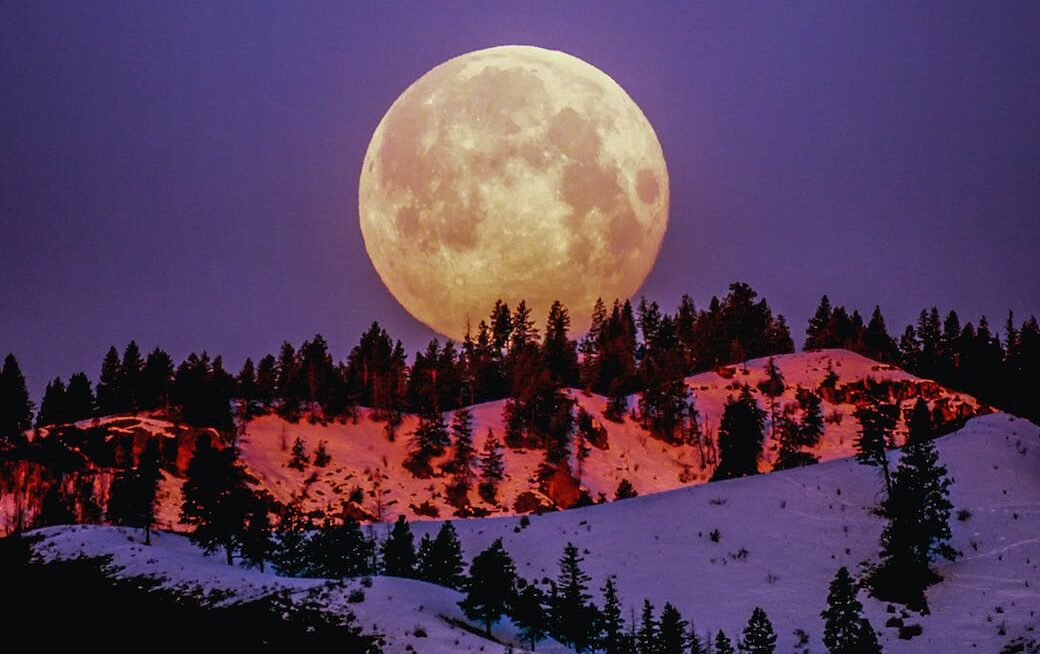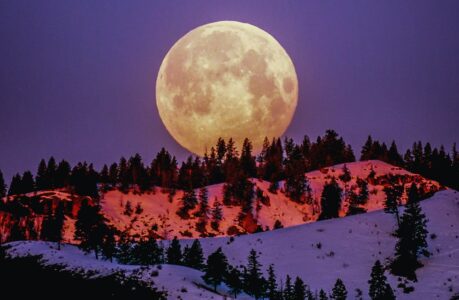The Moon Illusion is one of nature’s most captivating phenomena, where our celestial neighbor, the Moon, appears to balloon in size as it nears the horizon. But why does this happen? This article unlocks the secrets behind this astronomical enigma, leading readers on a journey through the eyes of science and history.
Introduction
As the evening hues paint the sky and the horizon cradles the Moon’s ascent, a remarkable transformation unfolds. The Moon, known for its consistent size and serene orbit, seemingly inflates into a grand spectacle. This is the Moon Illusion, a natural phenomenon that has mystified humans since ancient times. Gazing at the horizon, the Moon appears not only larger but also more accessible, as if one could reach out and touch its cratered surface. This illusion has sparked countless discussions, research papers, and debates among astronomers, psychologists, and philosophers alike.
But what is the Moon Illusion? It is a powerful optical illusion where the Moon appears up to 50% larger near the horizon than it does while high in the sky. Despite its frequency, the illusion remains as elusive and enchanting as ever. As we explore the secrets of this lunar spectacle, prepare to be drawn into the depths of human perception and the intricate workings of our universe.
The Historical Tapestry of the Moon Illusion
Throughout history, the Moon Illusion has danced across the canvas of human curiosity. Ancient civilizations wove tales around this lunar riddle, attributing it to the works of gods or other supernatural forces. Even Aristotle, the philosopher who sought to understand the world through observation and logic, pondered over this mysterious sight.
Fast forward to the Renaissance, and the debate continued. Did the atmosphere magnify the Moon, like a lens? Or did the human mind play tricks on us? The answer remained just out of reach, as tantalizing as the Illusion itself.
In modern times, we have turned to science to decipher the puzzle, yet the Moon Illusion retains its allure. It serves as a reminder that, despite our technological advances, the universe still holds secrets for us to unravel.
Peering Through the Lens of Science
To demystify the Moon Illusion, one must delve into the realms of astronomy and psychology. It’s a phenomenon that sits at the crossroads of external cosmic mechanics and the internal machinery of the human brain.
Astronomically, the Moon’s orbit is elliptical, which causes its distance from Earth to vary and, with it, its apparent size. However, this doesn’t account for the Illusion; the difference in distance is too small to cause such a drastic change in perception.
Psychologically, the Illusion is a product of the human mind’s interpretation of the world. Several theories have been proposed, and while none have emerged as the definitive answer, each sheds light on how we perceive the Moon against the backdrop of our surroundings.
The Theory of Apparent Distance
One of the most well-known explanations is the apparent distance hypothesis. This theory suggests that the Moon appears larger near the horizon because it seems farther away. When the Moon is overhead, there is nothing to compare it to, so our brain perceives it as closer and therefore smaller.
But how does our brain determine distance? Visual cues in our environment provide context. Trees, buildings, and other landscape features create a sense of scale and distance. Near the horizon, these cues trick our brain into thinking the Moon is further than it really is, and as a result, our mind compensates by enlarging our perception of it.
For an in-depth look at the apparent distance hypothesis, The Royal Astronomical Society provides a collection of research and papers exploring this and other astronomical phenomena.
The Angle of View and the Ponzo Illusion
Psychologists have linked the Moon Illusion to another optical trickery: the Ponzo Illusion. Named after Italian psychologist Mario Ponzo, who first demonstrated it in 1911, this illusion occurs when two lines converge, like railway tracks. If two identical objects are placed between these lines, the one closer to the converging point appears larger.
Relate this to the Moon Illusion, and the horizon becomes those converging lines. Our brain interprets the sky as a flattened dome, with the horizon acting as the farthest point. Thus, when the Moon is near it, it looks larger just like the objects in the Ponzo Illusion.
For a visual representation of the Ponzo Illusion, and to understand how it correlates with the Moon Illusion, The Exploratorium offers interactive exhibits that demonstrate how our perception can be so easily deceived.
The Enigma of Moon Colors
As if size weren’t enough, the Moon also changes color during the Illusion, casting hues of orange and red when near the horizon. This chromatic shift is a direct consequence of Earth’s atmosphere. When the Moon is low, its light passes through more of the Earth’s atmosphere, which scatters the shorter blue wavelengths and allows the longer red wavelengths to pass through.
This atmospheric filtering effect is akin to what happens during a sunset, giving the Moon its warm, amber glow, further enhancing the Illusion’s dramatic effect. To understand the interplay of light and atmosphere, organizations such as NASA offer resources and explanations on atmospheric optics and color phenomena.
A Dance of Celestial Perspective
The Moon Illusion is not just a trick of the mind or a sleight of hand by the universe. It’s a dance of perspective, a reminder that our place in the cosmos is both fixed and fluid. We are grounded on Earth, yet our minds can perceive and misperceive the heavens in fascinating ways.
By exploring the Moon Illusion, we are not just uncovering the secrets of a natural phenomenon; we are also peering into the workings of our own perception, the very essence of how we interpret the world around us. As we stand, feet planted on the ground, gazing at the horizon, the Moon’s exaggerated size becomes a symbol of our endless quest to understand our universe and ourselves.
The pursuit of understanding the Moon Illusion continues to inspire both scientists and stargazers. It’s a journey that transcends time, linking us with our ancestors who first looked up in wonder and will continue with future generations who will no doubt gaze upon the horizon with the same burning curiosity.
A Phenomenon for All Seasons
Interestingly, the Moon Illusion is not restricted to any particular season. It can be observed throughout the year, given the right conditions. This universal quality adds to its mystique, making it a shared experience across cultures and latitudes.
Regardless of whether the leaves are turning amber in fall or the summer air is thick with warmth, the Illusion persists. It’s a natural event that disregards seasons, unbound by the changing weather or the tilt of Earth’s axis. It simply requires the Moon, the horizon, and the human eye to manifest.
And so, the Moon Illusion remains, an enduring puzzle, a celestial illusion that continues to captivate and mystify. As we endeavor to unravel its mysteries, we are reminded that our perceptions are not always what they seem, and that sometimes, to see the truth, we must look beyond the Illusion.

